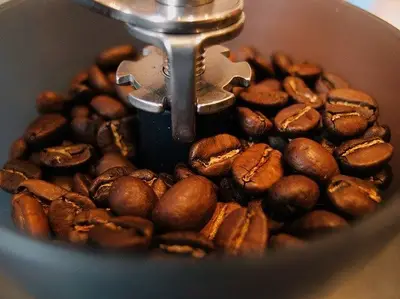Last Updated on 30/06/2021 by Miki
As a coffee lover, a good grinder could be one of the must-haves to make coffee at home. There are different types of grinders on the market including ones as a built-in for a coffee machine. To grind coffee beans freshly just before brewing will bring a beautiful aroma and amazing flavour to you. But what would you do if your coffee grinder has suddenly stopped working one morning? Will you give up your morning cup and go for a takeaway? Or if you opened a new bag of coffee beans and realised that it wasn’t ground coffee but whole beans, what would you do? No worries, you got the answer in this article 🙂
You will find 5 simple ways to grind coffee beans without a grinder here. Please keep in mind that these methods are for an emergency. I highly recommend that you get a new coffee grinder as soon as possible as it will be much more efficient and the end result will be much more satisfying.
This post may contain affiliate links. If you use these links to purchase something, I may earn a commission without any extra cost to you. I would appreciate it if you do so to keep this blog going!
A Blender
If you have a blender at home, this is a good coffee grinder alternative. Some home blenders have a ‘grind’ setting, which will actually help you use it as a coffee grinder. You can still use a blender without the setting, but there are some tips to follow in that case. You do not want to grind coffee beans with a blender too long. The reason is the fact that it will create heat and cook the beans’ natural oils that will lead to a bitter and harsh taste. Please also note that the result will be a relatively coarse grind and make sure that you wash the blender immediately after use. You don’t want the blender to leave the smell of stale coffee.
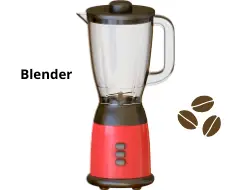
How to grind coffee beans with a blender
- Set a ‘grind’ setting if your blender has one or set a ‘high-speed’ if not.
- Add a small amount of coffee (half a cup is the maximum) into the blender and cover it with the lid firmly.
- Use a pulse setting to grind in short and quick bursts (5 seconds at one time is the maximum).
- Repeat this process until you get your preferred consistency (a total of 30 seconds is recommended).
- Tilt the blender slightly to the side while grinding if necessary (to achieve consistency).
- Empty the blender and add the next batch of beans until you get the right amount of ground coffee.
A Food Processor
Grinding coffee beans is a key step in making great coffee, but it can be a little challenging without the right equipment. The problem is that the small blades in most food processors are not very sharp and they can’t really grind coffee beans as finely as you need them to be. If you have a food processor with a blade that turns at high speeds, then it can work well for grinding coffee beans. Remember to clean out the food processor after you’re done. Now that you know the basics, here’s how to use a food processor to grind coffee beans:
How to grind coffee beans with a food processor
- Put the coffee beans in the food processor. This should be about 1 cup of beans.
- Turn the machine on and press down on the beans, making sure not to overfill the food processor.
- Continue to grind the beans until they are finely ground.
Notes: Grind your coffee beans in batches. The blades in a food processor are very thin and will only be able to break down a small number of coffee beans at a time before they break. This is why it’s best to grind in multiple batches.
A Mortar And Pestle
Grinding with a mortar and pestle has been a method used by cooks and pharmacists for a long time and it can produce fine grinds that are required to make espresso. It is a combined motion of hammering and rolling, which will help you create consistency in texture of grinds. Do not fill the mortar with coffee beans more than 1/4 of its capacity so that the beans do not hop out.
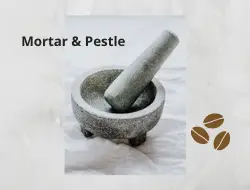
How to grind coffee beans with a mortar & pestle
- Fill your mortar with a small number of coffee beans to control and achieve the best consistency in grinds.
- Hold the mortar securely so that it won’t slip your hands for your own safety.
- Use the pestle to crush down the beans against the bottom of the mortar and stir them up when necessary to ensure consistency (Do not go overboard).
- Repeat the process until you get the desired amount of ground coffee.
A Hammer
You can use a hammer or a meat tenderiser to crush coffee beans. If you choose this method, please be cautious as a hammer can damage your hand/fingers or your kitchen benchtops. You will want to use a plastic bag or a piece of parchment paper in order to avoid creating any mess. The end result is coarse to medium grinds what are perfect for drip coffee machines.
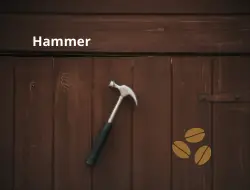
How to grind coffee beans with a hammer
- Place the right amount of coffee beans in a plastic bag or a piece of parchment paper (make sure to fold the edge of the parchment paper to seal the beans).
- Press down the beans firmly on the hammer to crush them until your preferred consistency is met.
- Continue to crush from one side of the bag and move gradually to the other to produce a consistent texture.
A Hand Mincer Or Garlic Press
This is a great option for those who have a limited budget, but still want to have a consistent, home-brewed cup of coffee. You may not be able to grind enough coffee for a whole pot at one time, but grinding enough for one cup will be a breeze. Some people have concerns about using a garlic press for anything other than garlic. The truth is that the mechanism is made of stainless steel, so there is no need to worry about the press absorbing flavours from anything other than the garlic.
How to grind coffee beans with a hand mincer or garlic press
- Take a handful of coffee beans and place them in the mincer or garlic press.
- Use the handle of the tool to reach down and start crushing the beans.
- When you get to about halfway down, turn the handle to the left and the right and continue crushing until you reach the bottom.
- Put the tool to the bottom of the now crushed beans and press down hard with a squeezing motion.
- Repeat the process until you get the desired amount and consistency of ground coffee.
A Rolling Pin
A rolling pin can be a good coffee grinder alternative no matter what material it is made of. You can also use a wine bottle or a tin of food if you don’t have a rolling pin at home. This method is good for French Press as it will produce coarser grinds (unless you observe the whole process of grinding the beans to ensure they are uniform). You will also need a plastic bag or a piece of parchment paper to put coffee beans in so that you won’t make any mess in the kitchen by scattering beans.
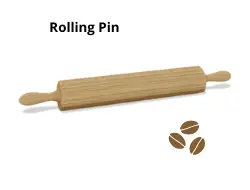
How to grind coffee beans with a rolling pin
- Place your preferred amount of coffee beans in a plastic bag or a piece of parchment paper, similar to the hammer method above.
- Use the rolling pin like a hammer, gently but firmly press down the beans to crush and roll over them.
- Roll the pin back and forth until you get your desired consistency.
- Continue the rolling and crushing process if the grinds are still too coarse.
A Knife
Grinding coffee beans with a knife will produce medium to medium-fine grinds. I believe that most people own a knife or two (probably more!) at home. A chef’s knife will be good with its wider blade that provides a larger surface to make the whole process easier and quicker. Please be careful in using a knife as the sharp edge can be dangerous.

How to grind coffee beans with a knife
- Place coffee beans on a chopping board.
- Place the knife flatly on top of the beans.
- Put your palm on top of the blade and press it down firmly without striking to crack the beans.
- Once the beans are cracked, continuously pressing down on the blade (you can pull it towards you so that the grinds become finer).
How To Grind Coffee Beans Without A Grinder FAQ
What can you use to grind coffee?
You can use both electrical appliances and manual tools. Here you got a list:
- Blender
- Food processor
- Mortar and pestle
- Hammer
- Hand mincer/Garlic press
- Rolling Pin
- Knife
Can I grind coffee beans in a blender?
Yes, you can! Just keep in mind that do not grind coffee beans with a blender too long. You do not want to create heat and cook the beans that will cause a bitter and harsh taste. Also, make sure to wash the blender immediately after use.
Can I grind coffee beans in a spice grinder?
The short answer is YES. But it might be a good idea to take a look at the grinder’s specs before you load up the beans. Most coffee grinders consist of a blade assembly and a burr assembly. The blade assembly is used to chop the beans, and the burrs are used to grind the coffee. The blade assembly is usually adjustable, so if you find that your blade is not actually chopping the beans, simply adjust it to a smaller setting. The best advice is to look at the specifications before you attempt to grind coffee beans in a grinder that is not designed for coffee.
Can I grind coffee beans with a magic bullet?
Although it can be possible, I don’t recommend it. The reason for that is that the actual motor in the magic bullet is too small. The motor is more designed for blending, not grinding, and that’s not what will be happening if you try to grind coffee beans in a magic bullet. The result of that will be beans that are inconsistently ground, which can cause some of the beans to dissolve depending on how much you ground them.
How long does it take to grind coffee beans manually?
It depends on the type of coffee bean you are grinding and how fine you want it but usually it takes about under 4 minutes.
How many coffee beans should I grind?
It’s a good thing that coffee enthusiasts know how many beans to put in their brewer because otherwise, they could end up with an excess of beans or a shortage of beans. In order to get the perfect strength and flavour, it’s important to measure your beans, and this can be tricky. A good rule of thumb is to use 17 grams of coffee beans per eight fluid ounces of water. In general, the ratio is 8: This will result in a bold 8-ounce cup of coffee, which is the perfect size for the standards.
What is the best way to grind coffee beans?
There are many ways to grind coffee beans, but one of the best ways is to use a burr grinder. Burr grinders are also known as mill grinders, and they work by crushing the beans instead of chopping them as a blade grinder does. The different mills or burrs on the grinder will grind the coffee to different degrees of fineness or coarseness. The effort required to use a burr grinder is slightly higher than what is required for using a blade grinder, but the use of a burr grinder will provide more uniformity and consistency in your coffee grinds, which is perfect for brewing coffee.
Can I brew coffee beans without grinding them?
While it can be possible, is it worth it? As a coffee lover, I always grind my beans before brewing. What is the point in brewing coffee without grinding the beans? Some people might say that it tastes fresher, but that doesn’t change the fact that the beans are going to be sitting there as insulation for a while before brewing. In contrast, those who enjoy coffee but don’t grind their beans typically like the flavour and don’t care about the extra time it takes to brew.
In Conclusion
There you got the answer to “How To Grind Coffee Beans Without A Grinder.” It will surely take your time and effort to achieve a good result. However, it is worth trying as freshly ground coffee beans will make a delicious cup of coffee! You might not want to go back to use pre-ground coffee.
If you would like to make coffee with an espresso machine, using a mortar and pestle method is recommended as it will provide fine grinds. With other methods, you can use a French press or a drip coffee maker for coarser grinds. The important tip to remember is grinding or crushing a small number of coffee beans at a time to make sure you are controlling the fineness and uniformity. In this way, you will be able to achieve your goal.
